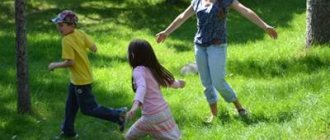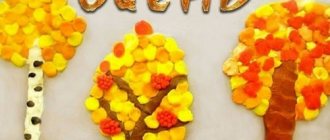Games for children at summer camp
Irina Rotanova
Games for children at summer camp
Games for children at summer camp
Game is a childhood companion. Summer camp is a place for gaining gaming practice experience. Playing at camp is a mandatory developmental activity for schoolchildren. The game can be a companion to any regime moment. With the help of games, the counselor will easily test children's , their mental and physical development, their compatibility and relationships with each other. Play is the shortest channel of influence on a child. On a walk in the forest, at a squad fire, at a crowd, the game will help you realize the needs of children to communicate with each other , introduce the children, and establish a good climate for human relations.
The educational potential of the game is reflected in its rules. The rules also suggest the methodology for organizing the game .
I offer you, counselors, “chains”
games for specific educational purposes.
When selecting games for children , focus on specific life situations of the squad. Outdoor games provide the joy of movement, give a boost of energy, relieve fatigue and at the same time provide friendly contacts and form a children's team. Educational games provide an opportunity for mental gymnastics, test and enrich children’s knowledge. Musical games develop rhythm and plasticity and expand musical horizons. Fun games provide space for creative self-expression. Place games Exercise games test the capabilities of children, form universal human qualities and manifestations.
I recommend turning to the children's and giving each child the opportunity to try themselves as a game . Advise the children to write down in notebooks all the games that will be learned in the unit. Enrich your children’s experience with folk games , about which it is rightly said: “What you acquire in the game, it will be useful in life.”
.
Outdoor games .
With a ball from a circle.
This game can be played on the court or in the hall. Two teams of 10 people play. For the game, a circle with a diameter of 20-25 meters is drawn. A second circle is drawn inside it with a diameter half the size of the first.
Before the game, one team (by lot)
is placed in a smaller circle, and the other moves away 10-12 meters into a pre-drawn square.
Here one of the players hides a small rubber ball in his pocket or shirt. After this, the players of the second team are located in a large circle. They keep their hands behind their backs, in their pockets or in their bosoms. Everyone tries to show that they have the ball. The player who has the ball hidden, after waiting for the right moment, throws the ball at one of the players of the first team. Whoever the ball hits leaves the circle. If the thrower misses, he is eliminated from the game .
The loser from the first team can remain in the circle if he manages to pick up the ball and throw it at one of the players of the other team before they run into the square. When all players on one team are knocked out, the game starts again. This time the winning team hides the ball.
I took the bait.
To play, you need a rope 2-3 meters long with a weight tied at the end - a bag of sand. The players form a circle, in the center of which stands the driver with a rope in his hands. He begins to unwind the rope so that it rotates just above the ground. The guys jump over the rope. The driver gradually raises the plane of rotation of the rope higher and higher until one of the guys “falls for the bait”
, that is, he will not be able to jump over a rotating rope.
The “caught one”
goes to drive. Game continues.
Defense of the fortress.
The fortress is a pyramid of three sticks. The defender of the fortress is the driver. The attackers are all the other guys (8-10 people, they form a circle, in the center of which there is this fortress, and next to it is the driver. To play, you need a volleyball. The guys should try to knock down the fortress. But the driver protects it, beating off those flying at fortress balls. To outwit the defender, the attackers throw the ball to each other, choosing the most convenient moment to attack the fortress. But the defender does not sleep either. Whoever manages to knock down the fortress becomes its defender, and the battle flares up with renewed vigor.
Three hundred.
This game is played with a single goal soccer ball. The gate can be real or conditional, for example, made of two stones. Two teams play, the number of players in each is no more than four people. One team stands at the goal, and the players of the other team shoot at the goal from the penalty mark. While one of the players is shooting, the rest of the players of this team stand near the goal and, if the ball from one of the players standing in the goal bounces into the field, they finish it off. Several team players can come out after the ball bounces into the field and try to take it away.
When all players have scored, the teams switch places. Points are awarded for hitting the goal as follows:
- if the ball flies into the goal at a height below the waist and none of the players touches it, the kickers are given 50 points;
- the same height, but someone touched the ball - 25 points;
- if the ball flies at a height below the waist and none of the players touches it - 75 points, and if it hits - 50 points;
- if the ball bounces off one of the players standing in the goal and the kicking team still scores it, then 15 points are given.
The game is to score three hundred points as quickly as possible. If a team has scored over three hundred points, then the extra points are calculated from three hundred.
If you have a real football goal, you can play up to 500 points, but the following conditions are added:
— for hitting the post — 50 points;
— to the cross — 150 points;
- to the crossbar - 100 points.
Circular rounder.
Players of one team, standing on both sides of the court, throw the ball at players of the other team running in the middle. You need to throw the ball at your feet, and jump over the ball with your feet apart. Salenny leaves the game . Then the teams change places.
Don't miss.
The players form a circle. The driver goes to the middle. The guys throw the ball among themselves in a circle, choosing the right moment to stain the driver. The driver must dodge all the time so that he cannot be insulted. If the player hits the driver, then he goes to the center of the circle, and the driver takes his place. If the player misses, he gets down on one knee and in this position continues to catch and throw the ball at the driver. In case of a second miss, he gets down on two knees and continues the game in this position. If, while throwing the ball at the driver, the player misses for the third time, he leaves the game . If he gets hit, he gets down on one knee again and continues to play. In case of a second hit, he has the right to continue the game while standing. The game lasts 20-30 minutes. The winner is the player who lasts longer than others.
Walk quickly.
The driver stands on one side of the playground, and all the other children stand on the other side, in their “home”
, marked with a line. The driver turns his back to the children and says, covering his face with his hands:
Walk quickly, Don't yawn, One, two, three, Stop!
While these words are being heard, all the players leave the “house”
and walk towards the driver, trying to get closer to him, but at a walk, not a run.
After the command “stop!”
everyone stops, and the driver turns to face them.
If the driver notices someone in motion, he sends him back to the “house”
.
The game continues and is repeated until one of the players manages to get closer to the driver. After this, all the players run to the “house”
, and the driver tries to make someone look bad. If he succeeds, he becomes a player, and the player becomes a driver.
The game is repeated several times and those guys who have never been caught are noted.
Note. Start moving from home
You just need to follow the words
“walk quickly
.
The offenders return “home”
and start all over again.
The cat is coming.
For the game, a platform is outlined, in the corner of which there is a
, and on the sides there are
“mouse holes”
. The role of the cat is played by the presenter, he is chosen using a counting rhyme.
The game begins with a saying uttered by the counselor:
Mice, mice, come out, Play, dance, Come out quickly, The mustachioed villain cat is sleeping!
"Mice"
they crawl out of
their “holes”
, dance, run, repeating the words in chorus:
Tra-ta-ta, tra-ta-ta, No mustachioed cat!
But then the counselor gives a signal: “The cat is coming!”
All
“mice”
should immediately freeze in place and not move.
The “cat”
goes around
the “mice”
and takes home those that move.
The brave “mice”
behind the
“cat”
can move, but must freeze if
the “cat”
turns towards them.
The counselor says: “The cat is gone!”
, and
the “mice”
come to life
again .
Game continues. The “cat”
changes after 2-3 repetitions; it is chosen from the uncaught
“mice”
.
Games while swimming (on the shore and in the water)
.
"Floating Logs"
.
On the water along the shore, a racing distance of 10-15 meters is marked. Two teams of 4-5 people stand at the start. Each team has a log that must be carried across the water to the finish line by any means. Whichever team can do this faster wins.
The ball is in the basket.
To play you need a floating basket with a sinker, a rubber ball or a volleyball. One team defends the basket, the other attacks it, trying to score the ball. The game lasts 5 minutes. Then the teams switch roles and the game resumes (again for 5 minutes)
.
to throw the ball into the basket the most times
during the game wins Horsemen fight.
In waist-deep water, two teams line up facing each other. In each team, partners sit astride each other. At the signal, the battle begins. The ranks converge, and those on horseback try to drag their rivals into the water. The winner is the team in which, at the signal “Stop!”
more riders remain.
Tag.
The game is played in a shallow place. A driver is appointed, who, after the signal to start the game , tries to catch up with someone and touch him with his hand. The players run away and dodge the driver. The caught person raises his hand and shouts “I’m a tag!”
and starts catching. You cannot stain a player who has plunged headlong into the water.
Sink the "ship"
.
To play, you need to place several tin cans on the water a short distance from the shore. 3-4 people stand opposite each of the cans on the shore. They try to throw pebbles into the jars in order to drown them as quickly as possible. The team that sank the “ship”
. The sunken jar must be retrieved and taken ashore.
Heron and frog.
At waist depth, all players form a circle and join hands. One is designated "heron"
, and three -
“frogs”
.
The “Heron”
catches
the “frogs
,” who are allowed to leave the circle only by diving under the hands of the players in different directions and returning to the circle again.
The “Heron”
can leave the circle and return to the circle only by jumping over the hands of the players
(to do this, they crouch a little)
.
The spotted “frog”
switches roles with
the “heron”
and the game continues.
Pike.
At chest-deep depths, the players line up. One of the players is chosen as a “pike”
.
He stands 10-15 steps in front of the line, turning his back to it. At the leader’s signal, the players begin to approach the “pike
,” trying to get as close to it as possible. Suddenly, the leader announces:
“The pike is swimming!” The “pike”
quickly turns around, and from that moment on the players must hide - dive headlong under the water.
The one whom the “pike”
discovers before he has time to dive is out of
the game . The winner is the one who managed to be the first to approach the “pike”
without being noticed.
Passing the ball.
At chest depth, two teams of 5-6 people line up in two parallel columns, one at a time, with their feet shoulder-width apart. The first numbers receive a ball. At the signal, they bend down, plunging their heads into the water, and pass the ball between their legs to the second players. They, in turn, bend down to receive the ball and pass it to the third, etc. When the ball reaches the last players, they run with it, stand in front of the teams and raise the ball high above their heads. that completes the task first wins
Terrain games.
Search.
The game is played in a familiar area of wooded area of about one square kilometer. Two drivers are selected. Each of them receives an item ( “treasure”
, which he must hide within 10-15 minutes at a distance of no more than 300 meters from the squad’s location.
Moreover, the guys know the type of “treasure”
- a box, a bag, a plate, etc. And then they go in search.
Whoever finds the “treasure”
is considered the winner. The drivers change, the game can continue.
Note. "Treasure"
You can hide not only on the ground, but also in trees and bushes.
You can’t a “treasure
,” but you can disguise it.
Cuckoos.
The game is played in the forest, on the edge. The size of the plot is approximately 500 x 500 meters. The players are divided into two teams. By drawing lots, players of one team go into the forest, climb trees in different places and disguise themselves as “cuckoos”
.
The boundaries of the area where the cuckoos
must be pre-established.
After 10-15 minutes, another team goes to look for the “cuckoos”
.
The time at which all the “cuckoos”
will be discovered is noted.
Then the players change roles. The team that managed to find all the “cuckoos”
is considered the winner.
"Cuckoos"
are obliged to occasionally give signals - cuckoo.
The found “cuckoo”
climbs down from the tree or comes out of hiding and goes to the counselor.
Find the checkbox.
In a section of rough terrain limited by clear boundaries (road, river, etc.), the counselor hides 20-30 flags in advance. Each player searches independently. When the agreed time is over (20-30 minutes), the number of flags found is counted during a general gathering. The winner is also named.
Note: the counselor can hide the flags in advance and play with the guys during the walk.
Observers.
While walking, you need to choose a place from which you have a good overview and can see many landmarks. The counselor invites the children to look at the area and remember landmarks for 2 minutes. And then, asking the guys to turn away from the panorama, he asks questions about where the landmarks are located. The correct answer is a point. For addition and correction of an incorrect answer - a point.
Good eye.
During a walk, stopping the guys and pointing at some object, the counselor asks how far away it is (how many steps)
. Everyone takes turns answering, and then checks who is right.
Note. The game helps well to get to the camp when, during the walk, the guys are tired, tired, or “slipped”
. In this case, everyone lines up and simultaneously walks and counts the steps to the object.
Developmental games and exercises
Moving target.
A keen eye and an accurate strike can be tested in the next competition. A board 2-3 meters long is placed on a chair so that one end rests on the ground. The player receives the ball and stands 5-8 steps from the board. The entertainer throws a ring across the board. At this time, you need to throw the ball so that it has time to fly through the moving ring. Each player is allowed to make 3 attempts.
Exact turn.
A chair is placed on the platform. Anyone who wants to take part in this game sits on it. The entertainer blindfolds the player or puts a paper cap on his head. The player must stand up at the entertainer’s signal. Then he takes 5 steps forward, turns to the right and, repeating this task 3 more times, walks along the four sides of the square, returns to the chair and sits on it.
What changed?
The presenter lays out 12-15 small objects and covers them with newspaper. The participants in the competition are given a task: within one minute they need to remember not only the objects, but also their location on the table. When the inspection is completed and the competitors leave, the presenter removes one of the objects and swaps two or three. The players are called one at a time. "What changed?"
- asks the presenter.
who most accurately notices all the changes
wins Before the line.
Several guys line up in one line according to height. The judge calls two participants in the competition, places them facing the line and asks them to remember the appearance of each comrade in the line. After this (2-3 minutes are given for inspection)
the competitors leave. At the direction of the judge, some of the guys standing in the line make minor changes to their costume: one, say, pins some kind of badge on his shirt, another, on the contrary, takes it off, and someone rolls up his sleeves or unbuttons his jacket, etc. .
Participants in the competition are called one at a time. Everyone must name those changes in the costumes of his comrades that he was able to notice. The one who demonstrates greater observation wins.
What is shown here?
You need to take an unfamiliar picture and a sheet of paper twice as long and twice as wide. In the very middle of the sheet, cut a round hole the size of a five-kopeck coin.
The presenter covers the picture with this sheet and places it in front of the players. You can view the picture only through this hole, without lifting the sheet, but gradually moving the hole across the picture. Everyone looks at it at the same time, but everyone moves the sheet for one minute.
Then the presenter suggests that someone tell in detail what is shown in the picture. The rest complement and correct it.
The picture opens and the presenter announces the winner (who spoke more correctly and in more detail)
.
The winner replaces the presenter. If the picture (reproduction)
is familiar to the children, then they should recognize it and remember its author.
Who will collect it faster?
The presenter lays out five different objects, for example, on the windowsill, tables. One of the guys is blindfolded, and he must as quickly as possible (but no longer than one minute)
collect the items in the order the leader tells him.
Continuing the game, the presenter changes the location of the objects and invites other participants to complete the same task. The winner is the one who collects all the items faster than others (the speed is determined by a clock with a second hand)
.
Check yourself.
The counselor lines up the kids in a line and offers to test their sense of time - disperse for a walk and gather again in this place in three minutes. When the guys start returning, the counselor records on his watch (stopwatch) who is the most accurate.
Musical games .
Recognize the song by its several sounds.
To do this, you need a player and a set of records with popular songs. The presenter puts on the first record he comes across, carefully lowers the needle and after 2-3 seconds raises it. The guys must name the song. If they don't catch it, the needle drops again for a few seconds. This can be done as a team competition. The winner is determined by the highest number of points for correctly recognizing the song.
Ring of songs.
The players form several groups. The game consists of teams taking turns performing one verse.
songs on a chosen topic. For example, about insects, about the seasons, soldiers' songs, songs about the sea, etc. The interval between the performance of songs by teams is 3 seconds, this rule must be strictly adhered to. For violation - a penalty point. The winner is the team that sings the last song.
Hit the note.
The guys become pairs and start dancing. Suddenly the music stops, but the dance must continue (the host explains this in advance)
.
The winner is the couple that is exactly in time with the music when the melody starts again.
You can try the same thing with the choir. Several people begin to sing the song out loud, then, on a signal, everyone continues to sing it to themselves, and then, on command, everyone again begins to sing out loud. Sometimes it turns out to be a funny discord.
Musical handkerchief.
Helpers in the game are an ordinary handkerchief and... broom. Music begins to sound, and the handkerchief is quickly passed around. Then the presenter loudly says: “Stop!”
, the music is interrupted, and the one who did not have time to pass the handkerchief to his neighbor is eliminated from
the game .
The music sounds again, again the handkerchief flies in a circle. The one who remains is the winner. And a broom appears in the leader’s hands. He asks everyone standing in the circle to pay by numbers. A musician plays a cheerful polka or waltz. Holding hands, everyone dances, moving first one way and then the other. But then the presenter calls the number and releases the broom from his hands. If the player with this number did not manage to pick up the broom, he is eliminated from the game . If he succeeds, he becomes a leader.
Remember the song.
The musician performs excerpts from various songs. Listeners need to write down the names of those that they recognized and remembered. The one with the most correct entries wins.
Dance on the "island"
.
8-10 pairs can take part in this game. To carry it out, you need to prepare 8-10 old newspapers. Each pair is given a newspaper, and the leader introduces the players to the rules of the game . All couples begin to dance to the music, observing one condition - not to leave their newspaper. If one of the partners violates this condition, the couple is eliminated from the competition. The music plays for 1-2 minutes, after which the newspaper is folded in half and the dance continues. The newspaper is folded until there is only one couple left who managed to stay on the small newspaper island. The leader must ensure that the guys dance and not stand, and record those who leave the newspaper.
Find out the song.
They choose drivers (one or more, they go out the door. All remaining participants are divided into 4 groups. From the selected verse of the song, each group receives one line. When the drivers (or driver)
enter, all groups sing their lines at the same time. The task is to find out what song is being performed.
Amusement games , fun, jokes.
Find a couple.
The leader sits the children in a circle and invites everyone to take off their shoes from their left feet. The shoes are folded in the center and all players are blindfolded. At the leader’s signal, they rush towards this pile, trying to find their shoes. The one who does it first wins.
Spider.
Draw two circles on the starting line. Divide the guys into two groups of 15-20 people and place each group in a circle. Now tie each group with ropes, you will get two “spiders”
.
On the command “March!”
both
“spiders”
begin to race their way to the finish line, where two other circles are drawn in which they must stand. All players must be either barefoot or wearing shoes.
Running with a trap.
Several small identical bags should be filled with freshly picked grass and tied. This will be a trap. Line up 8-10 pairs, tie a “trap”
and start a race.
Running with a trap
is not easy, so the running distance should not exceed 30 meters.
Cheerful artists.
Two teams of equal composition participate. To play you need boards and chalk or white paper and soft pencils. "To Artists"
- players are given a topic, for example, to draw a cow.
At the leader’s command, players run up to the board, put on blindfolds or caps, take chalk and begin to draw. At the command of the leader (whistle or clap), the “artists”
take off their headbands and each run back to their team, passing the headbands to the next players
(teams stand at the back of each other’s heads)
. They run to the board, put on bandages and continue the interrupted drawing. The first team to draw a cow without any major mistakes wins.
Igrodisco.
Don’t you think, children’s leaders, that in the camps , firstly, they unjustifiably call an ordinary dance evening a disco, secondly, that camp discos are a matter of dubious educational potential, and thirdly, that a disco must necessarily be a game disco? Yes, the guys in the camp really love disco. And yet, let’s control the repertoire of discotheques, give them back the ringleaders and entertainers (not necessarily disc jockeys, let’s come up with a unique program for each discotheque. Let all the groups take turns preparing the libretto of the disco game, the design of the dance area, let the games and fun .
At the disco you can hold competitions: for experts in the repertoire, for the best dance performance, for the best rhythmic composition “Circle of Friends”
, translators
(songs in English and other languages)
.
You can also conduct a questionnaire to study public opinion on the most popular song, singer, singer, ensemble, composer. The game disco program should include dance rounds (no more than 3 in one round), game rounds (2-3, attractions, group songs, competitions and surprises. And yet, on an equal footing with dancing, there is a place for various games and amusements. Below I will give a couple games specific to the game disco.
Implement crazy ideas
Sometimes ideas come into our heads that we usually ignore because they are “stupid” and “will be laughed at.” Children's camp is a great place to implement these ideas. Why don't we start singing hymns in praise of our king? Which king? Didn't you know? Petya is our new king! Or not paint stars on your face with face painting? (The main thing is that none of the children are allergic to it - do not forget to check this with the children themselves or their parents.) Anything, but, of course, within the bounds of decency.
Play games
From “There is contact” and “I” to “A crow flew” and “Bang-bang”. Every self-respecting counselor has a whole collection of games just for such cases.
If you are just getting ready for your first shift, and your piggy bank is empty, then it’s time to collect it from game collections (for example, summercamp) and advice from more experienced colleagues. VKontakte, for example, has quite a few groups for counselors, in some of them you can find quite a lot of practical advice for all occasions of camp life.
And if you need to keep the guys busy in the building, you can play one or two games in some board game - you took at least a couple with you, right?







